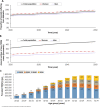Impact of trends and gender disparity in obesity on future type 2 diabetes in Turkey: a mathematical modelling analysis
- PMID: 35545390
- PMCID: PMC9096547
- DOI: 10.1136/bmjopen-2021-053541
Impact of trends and gender disparity in obesity on future type 2 diabetes in Turkey: a mathematical modelling analysis
Abstract
Background: Using a previously developed and validated mathematical model, we predicted future prevalence of type 2 diabetes mellitus (T2DM) and major modifiable risk factors (obesity, physical inactivity and smoking) stratified by age and sex in Turkey up to the year 2050.
Methods: Our deterministic compartmental model fitted nationally representative demographic and risk factor data simultaneously for Turkish adults (aged 20-79) between 1997 and 2017, then estimated future trends. Our novel approach explored the impact of future obesity trends on these projections, specifically modelling (1) a gradual fall in obesity in women after the year 2020 until it equalled the age-specific levels seen in men and (2) cessation of the rise in obesity after 2020.
Results: T2DM prevalence is projected to rise from an estimated 14.0% (95% uncertainty interval (UI) 12.8% to 16.0%) in 2020 to 18.4% (95% UI 16.9% to 20.9%) by 2050; 19.7% in women and 17.2% in men by 2050; reflecting high levels of obesity (39.7% for women and 22.0% for men in 2050). Overall, T2DM prevalence could be reduced by about 4% if obesity stopped rising after 2020 or by 12% (22% in women) if obesity prevalence among women could be lowered to equal that of men. The higher age-specific obesity prevalence among women resulted in 2 076 040 additional women developing T2DM by the year 2050.
Conclusion: T2DM is common in Turkey and will remain so. Interventions and policies targeting the high burden of obesity (and low physical activity levels), particularly in women, could significantly impact future disease burdens.
Keywords: diabetes & endocrinology; epidemiology; public health.
© Author(s) (or their employer(s)) 2022. Re-use permitted under CC BY-NC. No commercial re-use. See rights and permissions. Published by BMJ.
Conflict of interest statement
Competing interests: None declared.
Figures




Similar articles
-
Impact of mitigating obesity, smoking, and physical inactivity on type 2 diabetes mellitus burden in Oman: insights from mathematical modeling.BMJ Open Diabetes Res Care. 2024 Aug 3;12(4):e004248. doi: 10.1136/bmjdrc-2024-004248. BMJ Open Diabetes Res Care. 2024. PMID: 39097298
-
Estimating diabetes prevalence in Turkey in 2025 with and without possible interventions to reduce obesity and smoking prevalence, using a modelling approach.Int J Public Health. 2015 Jan;60 Suppl 1:S13-21. doi: 10.1007/s00038-014-0622-2. Epub 2014 Dec 4. Int J Public Health. 2015. PMID: 25471076
-
Forecasting the burden of type 2 diabetes mellitus in Qatar to 2050: A novel modeling approach.Diabetes Res Clin Pract. 2018 Mar;137:100-108. doi: 10.1016/j.diabres.2017.11.015. Epub 2017 Nov 22. Diabetes Res Clin Pract. 2018. PMID: 29175341
-
Diabetes and Obesity Trends in Tonga Over 40 Years.Asia Pac J Public Health. 2016 Sep;28(6):475-85. doi: 10.1177/1010539516645156. Epub 2016 Apr 27. Asia Pac J Public Health. 2016. PMID: 27122623 Review.
-
Physical inactivity and obesity: links with insulin resistance and type 2 diabetes mellitus.Diabetes Metab Res Rev. 2009 Sep;25 Suppl 1:S18-23. doi: 10.1002/dmrr.983. Diabetes Metab Res Rev. 2009. PMID: 19662619 Review.
Cited by
-
'No one ever asks about something that actually is relevant to my life': A qualitative study of diabetes and diabetes care experiences of young women with type 2 diabetes during their reproductive years.Diabet Med. 2023 Mar;40(3):e15017. doi: 10.1111/dme.15017. Epub 2022 Dec 9. Diabet Med. 2023. PMID: 36448267 Free PMC article.
-
Epidemiological impact of public health interventions against diabetes in Qatar: mathematical modeling analyses.Front Public Health. 2023 Jun 19;11:1167807. doi: 10.3389/fpubh.2023.1167807. eCollection 2023. Front Public Health. 2023. PMID: 37404285 Free PMC article.
-
Unraveling the Causal Relationship Between Non-Communicable Diseases, Obesity, and Health Expenditure: Insights from the Toda-Yamamoto Approach.Healthcare (Basel). 2024 Dec 24;13(1):1. doi: 10.3390/healthcare13010001. Healthcare (Basel). 2024. PMID: 39791608 Free PMC article.
-
Nonlinear association between the triglyceride-glucose index and diabetes mellitus in overweight and obese individuals: a cross-sectional retrospective analysis.Diabetol Metab Syndr. 2024 Aug 8;16(1):193. doi: 10.1186/s13098-024-01434-5. Diabetol Metab Syndr. 2024. PMID: 39118153 Free PMC article.
References
-
- Saeedi P, Petersohn I, Salpea P, et al. . Global and regional diabetes prevalence estimates for 2019 and projections for 2030 and 2045: Results from the International Diabetes Federation Diabetes Atlas, 9th edition. Diabetes Res Clin Pract 2019;157:107843. 10.1016/j.diabres.2019.107843 - DOI - PubMed
Publication types
MeSH terms
LinkOut - more resources
Full Text Sources
Medical
